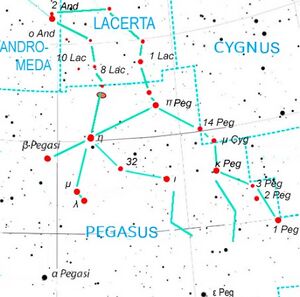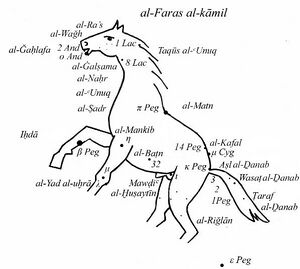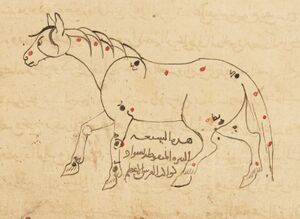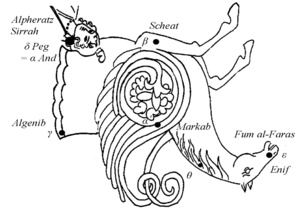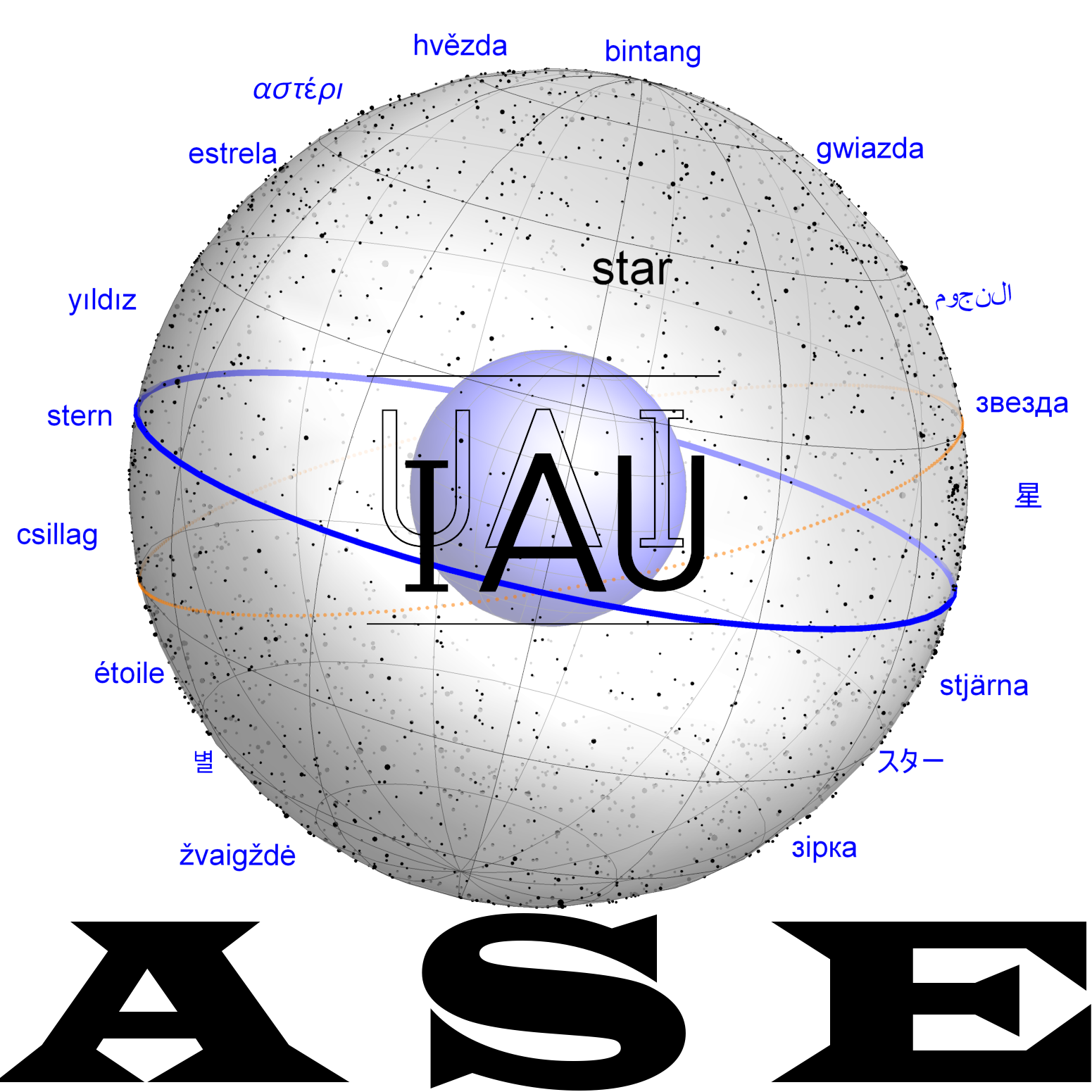Al Faras: Difference between revisions
No edit summary |
No edit summary |
||
| (30 intermediate revisions by 2 users not shown) | |||
| Line 1: | Line 1: | ||
{{ |
{{DISPLAYTITLE:Al Faras ( الفرس )}} |
||
{{distinguish|Alfarasalkamil}} |
|||
Al Faras الفرس is Arabic for The Horse. |
|||
[[File:And+horse+camel ArabianSky.png|thumb|The Indigenous Arabian constellations of The Horse and The Camel next to the adopted Syrian constellation of the Love Goddess with a Fish ([[Andromeda]]) in an al-Sufi manuscript dating AH 519/ 1125 CE, copied by 'Ali bin 'Abd al-Jalil bin 'Ali bin Muhammad. Islamic Arts Biennale 2025 exhibition: of al-Faras al-Kamil and [[An-naqa|al-Naqa]]. (Museum of Islamic Art in Doha, Qatar. MS.2.1998), [https://www.academia.edu/11565988/The_Most_Authoritative_Copy_of_%CA%BFAbd_al_Rahman_al_Sufi_s_Tenth_century_Guide_to_the_Constellations_In_God_is_Beautiful_He_Loves_Beauty_The_Object_in_Islamic_Art_and_Culture_ed_by_Sheila_Blair_and_Jonathan_Bloom_New_Haven_Yale_UP_2013_pp_122_155 study by Emilie Savage-Smith (2013)].]] |
|||
[[File:Sufi74v beduinConst Fish+Camel+Horse.jpg|thumb|Detail from "Kitāb Ṣuwar al-kawākib al-thābitah", Bodleian Library MS. Huntington 212, from Mosul 1170, [https://digital.bodleian.ox.ac.uk/objects/fba70a3f-2cf2-40cd-8d43-017b3eaed5c3/surfaces/ef471168-0326-4b79-b9b4-b6e91786c4fb/ digitalisation]. Clearly visible that the lady (goddess/ [[Andromeda]]) rides on the fish.]] |
|||
Al Faras الفرس is Arabic for The Horse, sometimes even called Al Faras Al Kamil (الفرس الكامل), "The Complete Horse", as opposed to the Greek constellation of a half horse that is now called Pegasus. The Arabian tradition may root in or connect to the Babylonian one which had a horse in that area, but we don't know where exactly. |
|||
==Etymology and History== |
==Etymology and History== |
||
[[File:Al-Faras al-Kāmil.png|thumb|Al-Faras al-Kāmil as described by al-Ṣūfī in Kitāb al-Kawākib]] |
|||
List of stars that WGSN dares to identify |
|||
{| class="wikitable sortable" |
|||
|+ |
|||
!id |
|||
!designation accoding to Khalid Al Ajaji's reconstruction in Stellarium |
|||
!ident. |
|||
!Vmag |
|||
|- |
|||
|1 |
|||
|snout of the Horse |
|||
|omi And |
|||
|3.62 |
|||
|- |
|||
|2 |
|||
|eye of the Horse |
|||
|11 Lac |
|||
|4.46 |
|||
|- |
|||
|3 |
|||
|the southern one in the mane |
|||
|1 Lac |
|||
|4.15 |
|||
|- |
|||
|4 |
|||
|the northern one in the mane |
|||
|HR 8495 |
|||
|4.49 |
|||
|- |
|||
|5 |
|||
|Breast of the Horse |
|||
|eta Peg (Matar) |
|||
|2.95 |
|||
|- |
|||
|6 |
|||
|the right front knee |
|||
|bet Peg (Scheat) |
|||
|2.42 |
|||
|- |
|||
|7 |
|||
|in the left front leg |
|||
|mu Peg (Sadalbari) |
|||
|3.48 |
|||
|- |
|||
|8 |
|||
|where the tail joins the body of the Horse |
|||
|mu1 Cyg |
|||
|4.7 |
|||
|- |
|||
|9 |
|||
|in the butt of the Horse |
|||
|kap Peg |
|||
|4.14 |
|||
|- |
|||
|10 |
|||
|in the tail |
|||
|2 Peg |
|||
|4.51 |
|||
|- |
|||
|11 |
|||
|in the belly of the Horse |
|||
|iot Peg |
|||
|3.77 |
|||
|- |
|||
|12 |
|||
|the tip of the Horse's tail |
|||
|9 Peg |
|||
|4.35 |
|||
|} |
|||
[[File:AL FARAS AL KAMIL RolandLaffitte map.jpeg|thumb|al Faras al Kamil, as_Sufi's "Complete Horse" mapped to the boundaries of modern IAU-constellations; Laffitte (2025).]] |
|||
=== Kunitzsch (195x, 56-57) === |
|||
=== '''''al-TERM''''' in Adams (2018),<ref>Danielle Adams, ''Rain Stars Set, Lunar Stations Rise'', 2018</ref> pp. xx-xx. === |
|||
[[File:AL FARAS AL KAMIL RolandLaffitte.jpeg|thumb|Al Faras al Kamil, as-Sufi's "complete horse", drawn by Laffitte (2025) with agreement of the WGSN-members. ]] |
|||
al-faras al-kāmil (at-tāmm)<blockquote>Zwischen die Darstellungen der beiden aufeinander folgenden ptolemäischen Bilder Andromeda und Dreieck schiebt Ṣūfī 133, 6ff. die umständliche Beschreibung eines “vollständigen Pferdes”, dessen Umrisse er folgendermaẞen angibt: |
|||
=== '''''al-TERM''''' per Khalid AlAjaji === |
|||
* der 23. Stern der Andromeda = ο Andromedae nebst Fl.2 Andromedae stehen auf der “Lippe” ''ğaḥfala''; |
|||
=== '''''al-TERM''''' in Laffitte (2012<ref>Roland Laffitte, ''Le ciel des Arabes'', 2012</ref>, 2025<ref>Roland Laffitte, ''Nommer les étoile: 500 noms hérités des Arabes - Apport de l'uranographie arabe'', Orient des Mots, 2025 ([https://uranos.fr/500-noms-herites-des-arabes/ online])</ref>). === |
|||
* der 18. des Pegasus = π Pegasi auf seinem “Leib” ''matn''; |
|||
* zwei Sterne (vermutlich Fl. 1 Pegasi und μ Cygni ) auf seiner “Kruppe” ''kafaluhu''; |
|||
* der 20. des Pegasus = κ Pegasi auf dem “Schwanzansatz” ''aṣl ḏanabihi''; |
|||
* dann zwei weitere, einer (vermutlich Fl. 2 Pegasi) in der “Mitte seines Schwanzes” ''wasaṭ ḏanabihī'' und |
|||
* einer (vermutlich Fl. 1 Pegasi) “hinter dem [Ptolemäischen] Sternbild Delphin” auf dem “Ende des Schwanzes” ''ṭaraf al-ḏanab''; |
|||
* der 7. des Pegasus = η Pegasi auf seiner “Schulter” ''mankibuhu''; |
|||
* ein Stern (vermutlich Fl. 32 Pegasi) auf seinem “Bauch” ''baṭnuhū''; |
|||
* der 19. des Pegasus = ι Pegasi an der “Stelle seiner Hoden” ''mawḍic ḫuṣayatihi''; |
|||
* β Pegasi auf “einem seiner Vorderfüẞe” ''iḥdā yadayhi''; |
|||
* der 9. und 10. des Pegasus = λμ auf dem “anderen Vorderfuẞ” ''al-yad al-uḫrā''; |
|||
* und schlieẞlich zwei schwache Sterne zwischen ε Pegasi und β Pegasi (vermutlich Fl. 9, 13 Pegasi) auf seinem beiden “Hinterfüẞen” ''riğlāhu'' (cf. ο p. 26). |
|||
</blockquote> |
|||
=== '''''al-Faras''''' in Adams (2018),<ref>Adams, Danielle Kira. ''Rain Stars Set, Lunar Stations Rise: Multivalent Textures of Pre-Islamic Arabian Astronomy and the Hegemonic Discourse of Order.'' The University of Arizona ProQuest Dissertations & Theses, 2018. </ref> pp. xx-xx. === |
|||
Adams interprets the term الفرس, al-Faras, in al-Qutayba<ref>Ibn Qutayba al-Dīnawarī, Abū Muḥammad ʿAbdallah b. Muslim. 1956. ''Kitāb al-anwāʾ (fī mawāsim al-ʿArab)''. Hyderabad: Maṭbaʿat Majlis Dāʾirat al-Maʿārif al-ʿUthmāniyya.</ref> as a constellation that differs from the (later) Arabic translations of the Greek term and identifies a smaller figure northwest of the ''Ίππος'' (The Horse in [[Pegasus]]). She points out: <blockquote>Paul Kunitzsch lists the Complete Horse (al-faras al-kāmil) among the asterisms of the Arabs, but it should be noted that the adjective “complete” only makes sense in opposition to the partial image of the Greek Pegasus (1961, 56-57). Thus, if this asterism had been recognized among Arabian tribes prior to the introduction of Greek astronomy, it likely would have been known simply as the Horse (al-faras).</blockquote>Furthermore, she explicitely states that the traces of the "complete horse" prior to as-Sufi are uncertain:<blockquote>... al-Ṣūfī traces the outline of an image of a “complete Horse” (al-faras al-kāmil) that was located to the west of the Well Bucket (al-dalw; 1981, 133-134). ... but most of the stars of the Arabian Horse fall within the modern boundaries of the constellation Pegasus, the well-known Winged Horse. Neither Ibn Qutayba nor al-Marzūqī identify this asterism, so there is no way to date it prior to its appearance in the work of al-Ṣūfī.</blockquote>[[File:Horse asSufi.JPG|thumb|Horse drawn in Kitāb Ṣuwar al-kawākib al-thābitah (Mosul 1170)]] |
|||
[[File:AlFaras asSufi1175.jpg|alt=stellarium map|thumb|Al Faras al Kamil (the complete horse) in the earliest copies of as-Sufi's manuscript (12th century), reconstruction by Khalid Al-Ajaji for Stellarium (CC BY). ]] |
|||
=== '''''al-Faras''''' per Khalid AlAjaji === |
|||
[[File:01S alFaras alKamilB.png|thumb|Al-Faras al-Kāmil (the Complete Horse) is a horse imagined and outlined by al-Ṣūfī in his book: Kitāb al-Kawākib.]] |
|||
The only mention of al-Faras, that I am aware of, is by al-Ṣufī in his discussion of Andromeda. He described a complete horse figure detailing the member stars. Al-Ṣufī did not indicate any connection of this figure to the Arabs. His description followed the section on the stars of the Arabs in the Greek constellation and after the table of those stars. Before outlining al-Faras, he also detailed another figure of a fish at the foot of Andromeda. Both figures were imagined by al-Ṣufī. He sometimes takes the liberty to imagine figures that he believes deserve mention, such as the Bowl between Lyra and Cygnus and the Crater between Cygnus and Aquila. |
|||
This is a translation of al- Ṣufī description of the Complete Horse: |
|||
The 23rd star, which precedes the three stars located in the right hand (part of the She-Camel's head), is situated in the lip of another Horse that resembles a horse more than al-Faras al-ʾʿẓam. Near this 23rd star, there is a small star that makes it appear double. From this small star, a series of stars accumulate in the face and head, forming a head shape. This series continues along the crest in an arc, resembling a horse's neck, and connects with a star on the back, which is the 18th star of al-Faras al-ʾʿẓam, located at the end of the right front leg. The series then passes through two stars in the rump, a star at the joint of the tail (the 20th star at the end of the left front leg of al-Faras al-ʾʿẓam), and finally two stars, one in the middle of the tail and the other at the end of the tail, behind the Dolphin. |
|||
Another series emerges from the 23rd star on the lip, passing through the throat latch and upper neck, completing a head shape. It then turns and follows the neck towards the chest, reaching a star on the shoulder (the 7th star, the northern of the two stars of the right knee of al-Faras al-ʾʿẓam). From this star, it passes a star in the belly, leaning towards the south, and finally reaches a star in the testicle (the 19th star on the left knee of al-Faras al-ʾʿẓam). The northern star of al-Farġ al-Awwal, located on the shoulder of al-Faras al-ʾʿẓam, is in one of its front legs, while the two stars in the chest of al-Faras al-ʾʿẓam are in the other leg. The back legs are represented by two contiguous and obscure stars between the bright star on the lip of al-Faras al-ʾʿẓam and the star at the joint of the tail, which is located at the extremity of the left front leg of al-Faras al-ʾʿẓam. |
|||
{| class="wikitable" |
|||
|+ |
|||
!id |
|||
!Al-Ṣūfī Description |
|||
!Designation |
|||
!VMag |
|||
|- |
|||
|1 |
|||
|The 23rd star, which precedes the three stars located in the right hand (part of the She-Camel's head), is situated in the lip of another Horse that resembles a horse more than al-Faras al-ʾʿẓam. |
|||
والكوكب الثالث والعشرون المتقدم للثلاثة التي على اليد اليمنى، وهي الثلاثة التي على رأس الناقة، هو على جحفلة فرسٍ آخر أحسن شبهًا بالفرس من الفرس الأعظم |
|||
|ο And |
|||
|3.6 |
|||
|- |
|||
|2 |
|||
|Near this 23rd star, there is a small star that makes it appear double. |
|||
وبقربه كوكبٌ صغيرٌ قد صار بهذا الكوكب الصغير مضعَّفًا |
|||
|2 And |
|||
|5.0 |
|||
|- |
|||
|3 |
|||
|From this small star, a series of stars accumulate in the face and head, forming a head shape. |
|||
ويخرج من عند الصغير سطرٌ من كواكب على وجهه ورأسه، قد تَوَّلَّدَ منه صورة الرأس |
|||
|15 Lac, |
|||
11 Lac, |
|||
6 Lac |
|||
|4.9 |
|||
4.4 |
|||
4.5 |
|||
|- |
|||
|4 |
|||
|This series continues along the crest in an arc, resembling a horse's neck, |
|||
ويمر على عُرْفِهِ على تقويس عنق الفرس |
|||
|HR 8485, |
|||
1 Lac, |
|||
HR 8475 |
|||
|4.5 |
|||
4.1 |
|||
5.3 |
|||
|- |
|||
|5 |
|||
|and connects with a star on the back, which is the 18th star of al-Faras al-ʾʿẓam, located at the end of the right front leg. |
|||
فيتصل بكوكب على متنه، وهو الثامن عشر من كوكبة الفرس الأعظم الذي على طرف اليد اليمنى |
|||
|π Peg |
|||
|4.3 |
|||
|- |
|||
|6 |
|||
|The series then passes through two stars in the rump, |
|||
ويمر بعد ذلك على كوكبين على كفله |
|||
|14 Peg, |
|||
μ1 Cyg |
|||
|5.0 |
|||
4.7 |
|||
|- |
|||
|7 |
|||
|a star at the joint of the tail (the 20th star at the end of the left front leg of al-Faras al-ʾʿẓam) |
|||
ثم على كوكب على أصل ذنبه، وهو العشرون الذي على طرف اليد اليسرى من الفرس الأعظم |
|||
|κ Peg |
|||
|4.1 |
|||
|- |
|||
|8 |
|||
|and finally two stars, one in the middle of the tail and the other at the end of the tail, behind the Dolphin. |
|||
ثم على كوكبين: أحدهما في وسط ذنبه، والآخر على طرف الذنب وهو خلف كوكبة الدلفين |
|||
|2 Peg, |
|||
1 Peg |
|||
|4.5 |
|||
4.1 |
|||
|- |
|||
|9 |
|||
|Another series emerges from the 23rd star on the lip, passing through the throat latch and upper neck, completing a head shape. |
|||
ويخرج من عند الثالث والعشرين الذي على الجحفلة أيضًا سطر يمر على الغلصمة والنحر فيتمم صورة الرأس |
|||
|16 Lac, |
|||
13 Lac |
|||
|5.6 |
|||
5.1 |
|||
|- |
|||
|10 |
|||
|It then turns and follows the neck towards the chest, reaching a star on the shoulder (the 7th star, the northern of the two stars of the right knee of al-Faras al-ʾʿẓam). |
|||
ويعطف فيمر نحو العنق إلى الصدر إلى كوكب على منكبه، وهو السابع الشمالي من الاثنين اللذين على الركبة اليمني من الفرس الأعظم |
|||
|12 Lac, |
|||
10 Lac, |
|||
η Peg |
|||
|5.2 |
|||
4.9 |
|||
2.9 |
|||
|- |
|||
|11 |
|||
|From this star, it passes a star in the belly, leaning towards the south, |
|||
ومنه إلى كوكب على بطنه مائل إلى الجنوب عنه |
|||
|HR 8564 |
|||
or |
|||
32 Peg |
|||
|5.8 |
|||
4.8 |
|||
|- |
|||
|12 |
|||
|and finally reaches a star in the testicle (the 19th star on the left knee of al-Faras al-ʾʿẓam). |
|||
ثم إلى كوكب على موضع خصيته، وهو التاسع عشر الذي على الركبة اليسرى من الفرس الأعظم أيضًا |
|||
|ι Peg |
|||
|3.8 |
|||
|- |
|||
|13 |
|||
|The northern star of al-Farġ al-Awwal, located on the shoulder of al-Faras al-ʾʿẓam, is in one of its front legs, |
|||
والشمالي من الفرغ الأول الذي على منكب الفرس الأعظم هو على إحدى يديه |
|||
|β Peg |
|||
|2.4 |
|||
|- |
|||
|14 |
|||
|while the two stars in the chest of al-Faras al-ʾʿẓam are in the other leg. |
|||
والاثنان اللذان على صدر الفرس الأعظم على اليد الأخرى |
|||
|μ Peg, |
|||
λ Peg |
|||
|3.5 |
|||
3.9 |
|||
|- |
|||
|15 |
|||
|The back legs are represented by two contiguous and obscure stars between the bright star on the lip of al-Faras al-ʾʿẓam and the star at the joint of the tail, which is located at the extremity of the left front leg of al-Faras al-ʾʿẓam. |
|||
ورجلاه كوكبان مقترنان خفيان بين النيِّر الذي على جحفلة الفرس الأعظم وبين الذي على أصل الذنب وهو الذي على طرف اليد اليسرى من الفرس الأعظم |
|||
|9 Peg, |
|||
13 Peg |
|||
|4.3 |
|||
5.3 |
|||
|} |
|||
=== '''''al-Faras''''' in Laffitte (2012<ref>Roland Laffitte, ''Le ciel des Arabes'', 2012</ref>, 2025<ref>Roland Laffitte, ''Nommer les étoile: 500 noms hérités des Arabes - Apport de l'uranographie arabe'', Orient des Mots, 2025 ([https://uranos.fr/500-noms-herites-des-arabes/ online])</ref>). === |
|||
Laffitte collated all Arabic translations from the Greek. The original constellation in Greek was named The Horse (''Ίππος)'', and only some of the cases are interpreted with wings ([[Pegasus]]).[[File:AlFaras Roland2025.png|thumb|al-faras, The Horse, is an Indigenous Arabian constellation (drawing Laffitte 2012). Names in contemporary catalogs (''Ίππος > al-Faras'', ''ap.'' ms. de St-Pétersbourg)]] |
|||
Reading Variants '''B19.''' |
|||
* ''Ίππος /'' / ''al-Faras al-Ṯānī'', « le Second Cheval » (Ḥağğāğ) |
|||
* ''al-Faras'', « le Cheval » (Isḥāq, Battānī) |
|||
* ''al-Faras al-A<sup>c</sup>ẓam'', « le Grand Cheval » (Isḥāq, Ṣūfī<ref>al-Ṣūfī, Abū al-Ḥusayn ʿAbd al-Raḥmān b. ʿUmar. 1981. ''Kitāb ṣuwar al-kawākib al-thamāniya wa al-arbaʿīn.'' Beirut: Dār al-Āfāq al-Jadīda.</ref>) |
|||
* ''al-Faras al-Muğannaḥ,'' « le Cheval ailé » (Bīrūnī) |
|||
* ''Buruṭūs ( ?)'' (Battānī) |
|||
==== '''''Individual Star Names''''' ==== |
|||
{| class="wikitable" |
|||
!Arabic |
|||
(original) |
|||
!Arabic transliteration |
|||
!French |
|||
(Laffitte 2025) |
|||
!English |
|||
!Author |
|||
!identified star |
|||
|- |
|||
| |
|||
|''Ğanb al-Faras'' |
|||
|le Flanc du Cheval |
|||
|The Flank of the Horse |
|||
|Battānī |
|||
|''α Peg'' |
|||
|- |
|||
| |
|||
|''Kitf al-Faras'' |
|||
|l’Épaule du Cheval |
|||
|The Shoulder<sup>?</sup> of the Horse |
|||
|Bīrūnī |
|||
|''α Peg'' |
|||
|- |
|||
| |
|||
|''Mankib al-Faras'' |
|||
|l’Épaule du Cheval |
|||
|The Shoulder<sup>?</sup> of the Horse |
|||
|Battānī |
|||
|''β Peg'' |
|||
|- |
|||
| |
|||
|''Ẓahr al-Faras'' |
|||
|le Dos du Cheval |
|||
|The Back of the Horse |
|||
|Battānī |
|||
|''γ Peg'' |
|||
|- |
|||
| |
|||
|''al-Matan'' |
|||
|le Paleron |
|||
|The Shoulder Blade |
|||
|Bīrūnī |
|||
|''γ Peg'' |
|||
|- |
|||
| |
|||
|''Matan al-Faras'' |
|||
|le Paleron du Cheval |
|||
|The Shoulder Blade of the Horse |
|||
|Marrākušī |
|||
|''γ Peg'' |
|||
|- |
|||
| |
|||
|''Ṭaraf al-Ğanāḥ'' |
|||
|le Bout de l’Aile |
|||
|the tip<sup>?</sup> of the wing |
|||
|Bīrūnī |
|||
|''γ Peg'' |
|||
|- |
|||
| |
|||
|''Ğanāḥ al-Faras'' |
|||
|l’Aile du Cheval |
|||
|The Wing of the Horse |
|||
|Battānī |
|||
|''γ Peg'' |
|||
|- |
|||
| |
|||
|''Ğanāḥ'' |
|||
|Aile |
|||
|The Wing |
|||
|Miṣrī |
|||
|''γ Peg'' |
|||
|- |
|||
| |
|||
|''Mankib al-Faras'' |
|||
|l’Épaule du Cheval |
|||
|The Shoulder of the Horse |
|||
|Battānī |
|||
|''δ Peg'' |
|||
|- |
|||
| |
|||
|''al-Nayra'' |
|||
|la Brillante |
|||
|The Bright One |
|||
|Bīrūnī |
|||
|''= α And'' |
|||
|- |
|||
| |
|||
|''Surrat al-Faras wa-ḥuwwa'' |
|||
|l’Ombilic du Cheval |
|||
|The Navel of the Horse |
|||
|Marrākušī |
|||
|''= α And'' |
|||
|- |
|||
| |
|||
|''Ğaḥlafat al-Faras'' |
|||
|la Lippe du Cheval |
|||
|The Lip of the Horse |
|||
|Battānī |
|||
|''ε Peg'' |
|||
|- |
|||
| |
|||
|''Fum al-Faras'' |
|||
|la Gueule du Cheval |
|||
|The Snout of the Horse |
|||
|Marrākušī |
|||
|''ε Peg'' |
|||
|} |
|||
Names in contemporary catalogs |
|||
{| class="wikitable" |
|||
!Arabic |
|||
(original) |
|||
!Arabic transliteration |
|||
!French |
|||
(Laffitte 2025) |
|||
!English |
|||
!Author |
|||
!identified stars |
|||
|- |
|||
| |
|||
|''ᶜUnuq al-Faras'' |
|||
|le Cou du Cheval |
|||
|The Neck of the Horse |
|||
|Marrākušī |
|||
|''ζ Peg'' |
|||
|- |
|||
| |
|||
|''Rukbat al-Faras'' |
|||
|le Genou du Cheval |
|||
|The Knee of the Horse |
|||
|Marrākušī |
|||
|''η Peg'' |
|||
|- |
|||
| |
|||
|''Ra’s al-Faras'' |
|||
|la Tête du Cheval |
|||
|The Head of the Horse |
|||
|Marrākušī |
|||
|''θ Peg'' |
|||
|- |
|||
| |
|||
|''al-Kaᶜb al-Ayman'' |
|||
|la Cheville droite |
|||
|The Right Ankle |
|||
|Bīrūnī |
|||
|''ι Peg'' |
|||
|- |
|||
| |
|||
|''Rukbat al-Faras'' |
|||
|Le Genou du Cheval |
|||
|The Knee of the Horse |
|||
|Miṣrī |
|||
|''ι Peg'' |
|||
|- |
|||
| |
|||
|''al-Kaᶜb al-aysar'' |
|||
|la Cheville gauche |
|||
|The Left Ankle |
|||
|Bīrūnī |
|||
|''κ Peg'' |
|||
|- |
|||
| |
|||
|''al-Kaᶜb al-aysar min al-Faras'' |
|||
|la Cheville gauche du Cheval |
|||
|The Left Ankle of the Horse |
|||
|Marrākušī |
|||
|''κ Peg'' |
|||
|- |
|||
| |
|||
|''Ṣadr al-Faras'' |
|||
|la Poitrine du Cheval |
|||
|The Breast of the Horse |
|||
|Marrākušī |
|||
|''λ Peg'' |
|||
|- |
|||
| |
|||
|''al-Rukbat al-aysar'' |
|||
|le Genou gauche |
|||
|The Left Knee |
|||
|Bīrūnī |
|||
|''π Peg'' |
|||
|} |
|||
==Discussion== |
==Discussion== |
||
I couldn't find any mention of al-Faras in ibn Qutayba book. If there is any, could it pointed out. |
|||
The caption in Mr. Laffitte section states that: "al-faras, The Horse, is an Indigenous Arabian constellation (drawing Laffitte 2012).", but the image is of the Greek constellation. |
|||
==IAU Working Group Star Names== |
==IAU Working Group Star Names== |
||
It came up in a discussion in 2025 to resemble this historical constellation by naming the brightest star in its head "Alfarasalkamil". This decision was announced on May 8 2025 by WGSN. |
|||
== Weblinks == |
== Weblinks == |
||
| Line 19: | Line 440: | ||
== Reference == |
== Reference == |
||
Ibn Qutayba al-Dīnawarī, Abū Muḥammad ʿAbdallah b. Muslim. 1956. ''Kitāb al-anwāʾ (fī mawāsim al-ʿArab)''. Hyderabad: Maṭbaʿat Majlis Dāʾirat al-Maʿārif al-ʿUthmāniyya. |
|||
Kunitzsch, Paul. 1961. ''Untersuchungen zur Sternnomenklatur der Araber.'' Wiesbaden: Otto Harrassowitz. |
Kunitzsch, Paul. 1961. ''Untersuchungen zur Sternnomenklatur der Araber.'' Wiesbaden: Otto Harrassowitz. |
||
| Line 30: | Line 451: | ||
[[Category:Constellation]] |
[[Category:Constellation]] |
||
[[Category:Asterism]] |
[[Category:Asterism]] |
||
[[Category:Peg]] |
|||
[[Category:And]] |
[[Category:And]] |
||
Latest revision as of 08:01, 9 August 2025

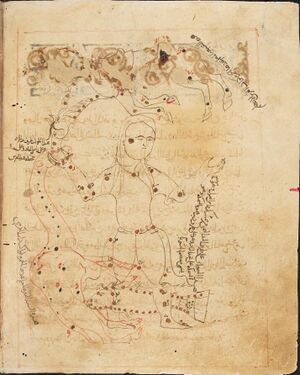
Al Faras الفرس is Arabic for The Horse, sometimes even called Al Faras Al Kamil (الفرس الكامل), "The Complete Horse", as opposed to the Greek constellation of a half horse that is now called Pegasus. The Arabian tradition may root in or connect to the Babylonian one which had a horse in that area, but we don't know where exactly.
Etymology and History
List of stars that WGSN dares to identify
| id | designation accoding to Khalid Al Ajaji's reconstruction in Stellarium | ident. | Vmag |
|---|---|---|---|
| 1 | snout of the Horse | omi And | 3.62 |
| 2 | eye of the Horse | 11 Lac | 4.46 |
| 3 | the southern one in the mane | 1 Lac | 4.15 |
| 4 | the northern one in the mane | HR 8495 | 4.49 |
| 5 | Breast of the Horse | eta Peg (Matar) | 2.95 |
| 6 | the right front knee | bet Peg (Scheat) | 2.42 |
| 7 | in the left front leg | mu Peg (Sadalbari) | 3.48 |
| 8 | where the tail joins the body of the Horse | mu1 Cyg | 4.7 |
| 9 | in the butt of the Horse | kap Peg | 4.14 |
| 10 | in the tail | 2 Peg | 4.51 |
| 11 | in the belly of the Horse | iot Peg | 3.77 |
| 12 | the tip of the Horse's tail | 9 Peg | 4.35 |
Kunitzsch (195x, 56-57)
al-faras al-kāmil (at-tāmm)
Zwischen die Darstellungen der beiden aufeinander folgenden ptolemäischen Bilder Andromeda und Dreieck schiebt Ṣūfī 133, 6ff. die umständliche Beschreibung eines “vollständigen Pferdes”, dessen Umrisse er folgendermaẞen angibt:
- der 23. Stern der Andromeda = ο Andromedae nebst Fl.2 Andromedae stehen auf der “Lippe” ğaḥfala;
- der 18. des Pegasus = π Pegasi auf seinem “Leib” matn;
- zwei Sterne (vermutlich Fl. 1 Pegasi und μ Cygni ) auf seiner “Kruppe” kafaluhu;
- der 20. des Pegasus = κ Pegasi auf dem “Schwanzansatz” aṣl ḏanabihi;
- dann zwei weitere, einer (vermutlich Fl. 2 Pegasi) in der “Mitte seines Schwanzes” wasaṭ ḏanabihī und
- einer (vermutlich Fl. 1 Pegasi) “hinter dem [Ptolemäischen] Sternbild Delphin” auf dem “Ende des Schwanzes” ṭaraf al-ḏanab;
- der 7. des Pegasus = η Pegasi auf seiner “Schulter” mankibuhu;
- ein Stern (vermutlich Fl. 32 Pegasi) auf seinem “Bauch” baṭnuhū;
- der 19. des Pegasus = ι Pegasi an der “Stelle seiner Hoden” mawḍic ḫuṣayatihi;
- β Pegasi auf “einem seiner Vorderfüẞe” iḥdā yadayhi;
- der 9. und 10. des Pegasus = λμ auf dem “anderen Vorderfuẞ” al-yad al-uḫrā;
- und schlieẞlich zwei schwache Sterne zwischen ε Pegasi und β Pegasi (vermutlich Fl. 9, 13 Pegasi) auf seinem beiden “Hinterfüẞen” riğlāhu (cf. ο p. 26).
al-Faras in Adams (2018),[1] pp. xx-xx.
Adams interprets the term الفرس, al-Faras, in al-Qutayba[2] as a constellation that differs from the (later) Arabic translations of the Greek term and identifies a smaller figure northwest of the Ίππος (The Horse in Pegasus). She points out:
Paul Kunitzsch lists the Complete Horse (al-faras al-kāmil) among the asterisms of the Arabs, but it should be noted that the adjective “complete” only makes sense in opposition to the partial image of the Greek Pegasus (1961, 56-57). Thus, if this asterism had been recognized among Arabian tribes prior to the introduction of Greek astronomy, it likely would have been known simply as the Horse (al-faras).
Furthermore, she explicitely states that the traces of the "complete horse" prior to as-Sufi are uncertain:
... al-Ṣūfī traces the outline of an image of a “complete Horse” (al-faras al-kāmil) that was located to the west of the Well Bucket (al-dalw; 1981, 133-134). ... but most of the stars of the Arabian Horse fall within the modern boundaries of the constellation Pegasus, the well-known Winged Horse. Neither Ibn Qutayba nor al-Marzūqī identify this asterism, so there is no way to date it prior to its appearance in the work of al-Ṣūfī.
al-Faras per Khalid AlAjaji
The only mention of al-Faras, that I am aware of, is by al-Ṣufī in his discussion of Andromeda. He described a complete horse figure detailing the member stars. Al-Ṣufī did not indicate any connection of this figure to the Arabs. His description followed the section on the stars of the Arabs in the Greek constellation and after the table of those stars. Before outlining al-Faras, he also detailed another figure of a fish at the foot of Andromeda. Both figures were imagined by al-Ṣufī. He sometimes takes the liberty to imagine figures that he believes deserve mention, such as the Bowl between Lyra and Cygnus and the Crater between Cygnus and Aquila.
This is a translation of al- Ṣufī description of the Complete Horse:
The 23rd star, which precedes the three stars located in the right hand (part of the She-Camel's head), is situated in the lip of another Horse that resembles a horse more than al-Faras al-ʾʿẓam. Near this 23rd star, there is a small star that makes it appear double. From this small star, a series of stars accumulate in the face and head, forming a head shape. This series continues along the crest in an arc, resembling a horse's neck, and connects with a star on the back, which is the 18th star of al-Faras al-ʾʿẓam, located at the end of the right front leg. The series then passes through two stars in the rump, a star at the joint of the tail (the 20th star at the end of the left front leg of al-Faras al-ʾʿẓam), and finally two stars, one in the middle of the tail and the other at the end of the tail, behind the Dolphin.
Another series emerges from the 23rd star on the lip, passing through the throat latch and upper neck, completing a head shape. It then turns and follows the neck towards the chest, reaching a star on the shoulder (the 7th star, the northern of the two stars of the right knee of al-Faras al-ʾʿẓam). From this star, it passes a star in the belly, leaning towards the south, and finally reaches a star in the testicle (the 19th star on the left knee of al-Faras al-ʾʿẓam). The northern star of al-Farġ al-Awwal, located on the shoulder of al-Faras al-ʾʿẓam, is in one of its front legs, while the two stars in the chest of al-Faras al-ʾʿẓam are in the other leg. The back legs are represented by two contiguous and obscure stars between the bright star on the lip of al-Faras al-ʾʿẓam and the star at the joint of the tail, which is located at the extremity of the left front leg of al-Faras al-ʾʿẓam.
| id | Al-Ṣūfī Description | Designation | VMag |
|---|---|---|---|
| 1 | The 23rd star, which precedes the three stars located in the right hand (part of the She-Camel's head), is situated in the lip of another Horse that resembles a horse more than al-Faras al-ʾʿẓam.
والكوكب الثالث والعشرون المتقدم للثلاثة التي على اليد اليمنى، وهي الثلاثة التي على رأس الناقة، هو على جحفلة فرسٍ آخر أحسن شبهًا بالفرس من الفرس الأعظم |
ο And | 3.6 |
| 2 | Near this 23rd star, there is a small star that makes it appear double.
وبقربه كوكبٌ صغيرٌ قد صار بهذا الكوكب الصغير مضعَّفًا |
2 And | 5.0 |
| 3 | From this small star, a series of stars accumulate in the face and head, forming a head shape.
ويخرج من عند الصغير سطرٌ من كواكب على وجهه ورأسه، قد تَوَّلَّدَ منه صورة الرأس |
15 Lac,
11 Lac, 6 Lac |
4.9
4.4 4.5 |
| 4 | This series continues along the crest in an arc, resembling a horse's neck,
ويمر على عُرْفِهِ على تقويس عنق الفرس |
HR 8485,
1 Lac, HR 8475 |
4.5
4.1 5.3 |
| 5 | and connects with a star on the back, which is the 18th star of al-Faras al-ʾʿẓam, located at the end of the right front leg.
فيتصل بكوكب على متنه، وهو الثامن عشر من كوكبة الفرس الأعظم الذي على طرف اليد اليمنى |
π Peg | 4.3 |
| 6 | The series then passes through two stars in the rump,
ويمر بعد ذلك على كوكبين على كفله |
14 Peg,
μ1 Cyg |
5.0
4.7 |
| 7 | a star at the joint of the tail (the 20th star at the end of the left front leg of al-Faras al-ʾʿẓam)
ثم على كوكب على أصل ذنبه، وهو العشرون الذي على طرف اليد اليسرى من الفرس الأعظم |
κ Peg | 4.1 |
| 8 | and finally two stars, one in the middle of the tail and the other at the end of the tail, behind the Dolphin.
ثم على كوكبين: أحدهما في وسط ذنبه، والآخر على طرف الذنب وهو خلف كوكبة الدلفين |
2 Peg,
1 Peg |
4.5
4.1 |
| 9 | Another series emerges from the 23rd star on the lip, passing through the throat latch and upper neck, completing a head shape.
ويخرج من عند الثالث والعشرين الذي على الجحفلة أيضًا سطر يمر على الغلصمة والنحر فيتمم صورة الرأس |
16 Lac,
13 Lac |
5.6
5.1 |
| 10 | It then turns and follows the neck towards the chest, reaching a star on the shoulder (the 7th star, the northern of the two stars of the right knee of al-Faras al-ʾʿẓam).
ويعطف فيمر نحو العنق إلى الصدر إلى كوكب على منكبه، وهو السابع الشمالي من الاثنين اللذين على الركبة اليمني من الفرس الأعظم |
12 Lac,
10 Lac, η Peg |
5.2
4.9 2.9 |
| 11 | From this star, it passes a star in the belly, leaning towards the south,
ومنه إلى كوكب على بطنه مائل إلى الجنوب عنه |
HR 8564
or 32 Peg |
5.8
4.8 |
| 12 | and finally reaches a star in the testicle (the 19th star on the left knee of al-Faras al-ʾʿẓam).
ثم إلى كوكب على موضع خصيته، وهو التاسع عشر الذي على الركبة اليسرى من الفرس الأعظم أيضًا |
ι Peg | 3.8 |
| 13 | The northern star of al-Farġ al-Awwal, located on the shoulder of al-Faras al-ʾʿẓam, is in one of its front legs,
والشمالي من الفرغ الأول الذي على منكب الفرس الأعظم هو على إحدى يديه |
β Peg | 2.4 |
| 14 | while the two stars in the chest of al-Faras al-ʾʿẓam are in the other leg.
والاثنان اللذان على صدر الفرس الأعظم على اليد الأخرى |
μ Peg,
λ Peg |
3.5
3.9 |
| 15 | The back legs are represented by two contiguous and obscure stars between the bright star on the lip of al-Faras al-ʾʿẓam and the star at the joint of the tail, which is located at the extremity of the left front leg of al-Faras al-ʾʿẓam.
ورجلاه كوكبان مقترنان خفيان بين النيِّر الذي على جحفلة الفرس الأعظم وبين الذي على أصل الذنب وهو الذي على طرف اليد اليسرى من الفرس الأعظم |
9 Peg,
13 Peg |
4.3
5.3 |
al-Faras in Laffitte (2012[3], 2025[4]).
Laffitte collated all Arabic translations from the Greek. The original constellation in Greek was named The Horse (Ίππος), and only some of the cases are interpreted with wings (Pegasus).
Reading Variants B19.
- Ίππος / / al-Faras al-Ṯānī, « le Second Cheval » (Ḥağğāğ)
- al-Faras, « le Cheval » (Isḥāq, Battānī)
- al-Faras al-Acẓam, « le Grand Cheval » (Isḥāq, Ṣūfī[5])
- al-Faras al-Muğannaḥ, « le Cheval ailé » (Bīrūnī)
- Buruṭūs ( ?) (Battānī)
Individual Star Names
| Arabic
(original) |
Arabic transliteration | French
(Laffitte 2025) |
English | Author | identified star |
|---|---|---|---|---|---|
| Ğanb al-Faras | le Flanc du Cheval | The Flank of the Horse | Battānī | α Peg | |
| Kitf al-Faras | l’Épaule du Cheval | The Shoulder? of the Horse | Bīrūnī | α Peg | |
| Mankib al-Faras | l’Épaule du Cheval | The Shoulder? of the Horse | Battānī | β Peg | |
| Ẓahr al-Faras | le Dos du Cheval | The Back of the Horse | Battānī | γ Peg | |
| al-Matan | le Paleron | The Shoulder Blade | Bīrūnī | γ Peg | |
| Matan al-Faras | le Paleron du Cheval | The Shoulder Blade of the Horse | Marrākušī | γ Peg | |
| Ṭaraf al-Ğanāḥ | le Bout de l’Aile | the tip? of the wing | Bīrūnī | γ Peg | |
| Ğanāḥ al-Faras | l’Aile du Cheval | The Wing of the Horse | Battānī | γ Peg | |
| Ğanāḥ | Aile | The Wing | Miṣrī | γ Peg | |
| Mankib al-Faras | l’Épaule du Cheval | The Shoulder of the Horse | Battānī | δ Peg | |
| al-Nayra | la Brillante | The Bright One | Bīrūnī | = α And | |
| Surrat al-Faras wa-ḥuwwa | l’Ombilic du Cheval | The Navel of the Horse | Marrākušī | = α And | |
| Ğaḥlafat al-Faras | la Lippe du Cheval | The Lip of the Horse | Battānī | ε Peg | |
| Fum al-Faras | la Gueule du Cheval | The Snout of the Horse | Marrākušī | ε Peg |
Names in contemporary catalogs
| Arabic
(original) |
Arabic transliteration | French
(Laffitte 2025) |
English | Author | identified stars |
|---|---|---|---|---|---|
| ᶜUnuq al-Faras | le Cou du Cheval | The Neck of the Horse | Marrākušī | ζ Peg | |
| Rukbat al-Faras | le Genou du Cheval | The Knee of the Horse | Marrākušī | η Peg | |
| Ra’s al-Faras | la Tête du Cheval | The Head of the Horse | Marrākušī | θ Peg | |
| al-Kaᶜb al-Ayman | la Cheville droite | The Right Ankle | Bīrūnī | ι Peg | |
| Rukbat al-Faras | Le Genou du Cheval | The Knee of the Horse | Miṣrī | ι Peg | |
| al-Kaᶜb al-aysar | la Cheville gauche | The Left Ankle | Bīrūnī | κ Peg | |
| al-Kaᶜb al-aysar min al-Faras | la Cheville gauche du Cheval | The Left Ankle of the Horse | Marrākušī | κ Peg | |
| Ṣadr al-Faras | la Poitrine du Cheval | The Breast of the Horse | Marrākušī | λ Peg | |
| al-Rukbat al-aysar | le Genou gauche | The Left Knee | Bīrūnī | π Peg |
Discussion
I couldn't find any mention of al-Faras in ibn Qutayba book. If there is any, could it pointed out.
The caption in Mr. Laffitte section states that: "al-faras, The Horse, is an Indigenous Arabian constellation (drawing Laffitte 2012).", but the image is of the Greek constellation.
IAU Working Group Star Names
It came up in a discussion in 2025 to resemble this historical constellation by naming the brightest star in its head "Alfarasalkamil". This decision was announced on May 8 2025 by WGSN.
Weblinks
Reference
Kunitzsch, Paul. 1961. Untersuchungen zur Sternnomenklatur der Araber. Wiesbaden: Otto Harrassowitz.
al-Ṣūfī, Abū al-Ḥusayn ʿAbd al-Raḥmān b. ʿUmar. 1981. Kitāb ṣuwar al-kawākib al-thamāniya wa al-arbaʿīn. Beirut: Dār al-Āfāq al-Jadīda.
- ↑ Adams, Danielle Kira. Rain Stars Set, Lunar Stations Rise: Multivalent Textures of Pre-Islamic Arabian Astronomy and the Hegemonic Discourse of Order. The University of Arizona ProQuest Dissertations & Theses, 2018.
- ↑ Ibn Qutayba al-Dīnawarī, Abū Muḥammad ʿAbdallah b. Muslim. 1956. Kitāb al-anwāʾ (fī mawāsim al-ʿArab). Hyderabad: Maṭbaʿat Majlis Dāʾirat al-Maʿārif al-ʿUthmāniyya.
- ↑ Roland Laffitte, Le ciel des Arabes, 2012
- ↑ Roland Laffitte, Nommer les étoile: 500 noms hérités des Arabes - Apport de l'uranographie arabe, Orient des Mots, 2025 (online)
- ↑ al-Ṣūfī, Abū al-Ḥusayn ʿAbd al-Raḥmān b. ʿUmar. 1981. Kitāb ṣuwar al-kawākib al-thamāniya wa al-arbaʿīn. Beirut: Dār al-Āfāq al-Jadīda.

